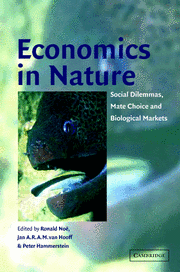Book contents
- Frontmatter
- Contents
- List of contributors
- Preface
- Acknowledgments
- 1 Games and markets: economic behaviour in humans and other animals
- Part I Economic behaviour in social networks
- Part II Biological markets
- Part III Mating markets
- 9 Human mate choice strategies
- 10 How does mate choice contribute to exaggeration and diversity in sexual characters?
- 11 Information about sperm competition and the economics of sperm allocation
- 12 The economics of male mating strategies
- Index
10 - How does mate choice contribute to exaggeration and diversity in sexual characters?
Published online by Cambridge University Press: 04 August 2010
- Frontmatter
- Contents
- List of contributors
- Preface
- Acknowledgments
- 1 Games and markets: economic behaviour in humans and other animals
- Part I Economic behaviour in social networks
- Part II Biological markets
- Part III Mating markets
- 9 Human mate choice strategies
- 10 How does mate choice contribute to exaggeration and diversity in sexual characters?
- 11 Information about sperm competition and the economics of sperm allocation
- 12 The economics of male mating strategies
- Index
Summary
Introduction
Males of many species are typified by exaggerated secondary sexual traits and courtship displays (Darwin 1871; Andersson 1994). These sexual signals are highly variable amongst closely related species and appear to change very quickly in evolutionary time (Iwasa & Pomiankowski 1995). Two classic examples of exaggeration and diversity in sexual characters are the cichlid fish species flocks of the African Great Lakes (Fryer & Iles 1980) and the birds of paradise found in south-east Asia (Coates 1990).
In this chapter we will consider how female mating preferences cause the evolution of exaggeration and diversity in male sexual displays. As recognised by Fisher (1930) this requires an understanding of how female sexual preferences evolve. Two main hypotheses have dominated thinking on this question, Fisher's runaway and the handicap process. These ideas concern the benefits of mate choice. Fisher's runaway assumes that females select mates with exaggerated ornaments because they are attractive. Choosy females benefit as their male offspring inherit genes for attraction. The handicap process assumes that the degree of exaggeration reveals male quality. In this case, choosy females benefit directly because higher-quality males make better fathers or indirectly because quality is inherited by their offspring. These are not the only forces affecting the evolution of mate choice. For example, inbreeding avoidance and species recognition can be important. However, Fisher's runaway and the handicap process seem the best candidates for explaining exaggeration and diversity.
The evolution of female preferences for male sexual ornaments has been treated in a number of ways, using major gene, quantitative genetic and game theory models. In the following sections we will summarise our work using quantitative genetic models.
- Type
- Chapter
- Information
- Economics in NatureSocial Dilemmas, Mate Choice and Biological Markets, pp. 203 - 220Publisher: Cambridge University PressPrint publication year: 2001
- 3
- Cited by



